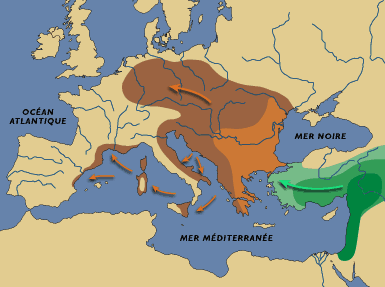- Accueil
- The Process of Neolithization In Europe, The Near-East Origin
- The Process of Neolithization in Europe, The Near-East Origin
The neolithization of Europe began with a very early origin in the Near East, more precisely in the Eastern Mediterranean, where agriculture (wheat and barley) appeared at the end of the ninth millennium, BC. Then, from this origin, the practice of agriculture along with the domestication of wild animals (goat and sheep and later cows and pigs) and the settling of itinerant communities, diffused both eastward and westward, into Mesopotamia and Anatolia respectively, throughout the eighth millennium, BC.
The process of neolithization reached the European continent as early as the seventh millennium, BC, as much by the expansion along coastal regions, as by the crossing of the Bosphore in Turkey and extended quickly into all of the Balkan peninsula and the north of the Danube. During more than a millennium the Neolithic Balkans, at first homogeneous, became stable and diversified in the region circumscribed by Temperate Europe and Mediterranean Europe. After this, began the process of rapid colonization of new territories from both of these directions.
The first axis of colonization starting with the eastern border of the fertile plains of
loess in central Europe, and rapidly swarmed northward (Poland and The Ukraine), then toward the northwest (Bohemia and Central Germany) toward the west, returning along the course of the Danube, and then to the Rhine. This is referred to as the "Danubian Migration".
The second movement took a southern route along the Adriatic coast and by a sea route toward Italy, then toward the Mediterranean coast of France and the Iberian Peninsula. This is referred to as the "Neolithic Cardial". Thus, the first Neolithic civilizations, which, by the end of the fifth millennium, came together in France (Europe's peninsula) were the result of a long progression across the continent.



